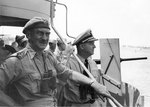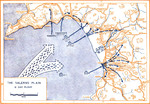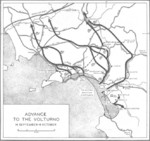Operation Avalanche
Contributor: C. Peter Chen
ww2dbaseHaving driven Axis troops out of the island of Sicily by 17 Aug 1943, the Allies launched Operation Avalanche, the invasion of mainland Italy. Given a choice of two landing sites, the opening of the Volturno River north of Naples or Salerno southeast of Naples, the latter was chosen as it had landing beaches favorable to invaders and it had nearby major roads and airfields that could be used by the Allies after a successful invasion. Operation Baytown and Operation Slapstick were launched to prepare for the main Operation Avalanche invasion, although the latter was actually commenced on the same day as Operation Avalanche.
ww2dbaseOperation Baytown was embarked upon by British XIII Corps under the command of Bernard Montgomery. On 3 Sep 1943, six days prior to the Salerno landing, British and Canadian troops landed at Reggio Calabria at the southwestern tip of Italy, intending to tie down German troops in southern Italy and perhaps even drawing German troops away from the Salerno area further north. This operation ultimately did not achieve its intended effect as the German commander-in-chief Albert Kesselring correctly deduced the main Allied target was further north up the coast; instead of keeping troops south to counter the British-Canadian attack, Kesselring actually gradually pulled German LXXVI Panzer Corps back, leaving only a single regiment and some Italian formations to deal with the Baytown invasion.
ww2dbaseOperation Slapstick, which saw the amphibious landing of Taranto and Brindisi in southeastern Italy, was conducted by troops of British 1st Airborne Division. Although two port cities had been secretly made available to the Allies during the secret armistice negotiations, Allied Supreme Commander Dwight Eisenhower decided to land a large number of troops there as another attempt to draw German attention away from the Salerno landings. The four British cruisers that carried the invasion troops arrived at Taranto at 1500 hours on 9 Sep, where they were guided through the defensive minefield by the Italians as previously agreed upon. The Taranto landing was met with no resistance as German troops had already been pulled back per Kesselring's orders days prior. Two days later, the British paratroopers captured Brindisi, again without resistance, although along the way the advance was met with German harassment. On the same day, the British paratroopers who pushed westward linked up with Canadian troops of XIII Corps. The Slapstick offensive would push on to capture the airfield at Gioia del Colle in mid-Sep 1943, after which it would be halted to consolidate the territorial gains. The British paratroopers would be withdrawn to Britain by Nov 1943.
ww2dbaseThe main Operation Avalanche offensive against Salerno took place on 9 Sep 1943, the same day as the Taranto operation. To gain an element of surprise, the landing commenced without pre-invasion naval and aerial bombardment, but Allied leadership did not know that Kesselring had already been preparing for a possible invasion in the general region, thus no surprise could truly be achieved. The 165,000-strong Salerno invasion force, US Fifth Army under the command of Lieutenant General Mark Clark, was consisted of US VI Corps (Major General Ernest Dawley), British X Corps (Lieutenant General Richard McCreery), and US 82nd Airborne Division in reserve. Despite the broad 56-kilometer front, only three divisions, two British and one American, made up the initial assault force, with the British landing north of the Sele River near Montecorvino and the Americans to the south of the river at Paestum. A small force of US Rangers and British Commandos would land northwest of the British landing beaches to secure the roads leading to Naples up the coast.
ww2dbaseOpposite the Allies stood several German divisions, all of which had been vigilant of an Allied attack as warned by Kesselring.
ww2dbaseAt Paestum, the two inexperienced battalions of US 36th Division which landed first nearly fell into disarray when they faced enemy fire, but was able to hold the beachhead as the next wave of troops arrived. The British troops further north were able to push inland for about 8 to 11 kilometers. Through the following three days, both sides built up their strength in the region, but it would be the Germans who would reach their desired level of strength (six divisions) first for a major offensive, while Allies shifted to a defensive stance. The German counterattack began on 13 Sep, with the main attack striking in the region near Battipaglia, intending to divide the British X Corps and the US VI Corps. The afternoon of 13 Sep saw Allied units, mainly the Americans as the German efforts focused more in the Sele River region, being pushed back and suffering heavy casualties in the process; two battalions of US 82nd Airborne Division were brought in to help hold the line. In the afternoon on the following day, US 180th Infantry Regiment arrived near Paestum, relieving the paratroopers. The German advances were slowed on 15 Sep, largely because of heavy naval gunfire and aerial bombardment. On 16 Sep, German troops launched a second attack against positions held by troops of British X Corps, but made little progress.
ww2dbaseMeanwhile, Bernard Montgomery's force which had participated in Operation Baytown slowly made their way up Italy. By 16 Sep, British 5th Infantry Division had reached Sapri, less than 100 kilometers southeast of Salerno, thus nearly linking up the two forces. In light of the German inability to drive off the Allied invasion, and the now near link up of two large Allied forces, Kesselring was advised by German Tenth Army commanding officer Heinrich von Vietinghoff to call off the offensive, fall back, and form a defensive line; Kesselring agreed with this suggestion and gave such orders on 17 Sep. Kesselring believed that even as he gave the Allies control of Salerno, the terrain of Italy would prove to be favorable for defense. Together with his orders to pull back from Salerno were orders to destroy key bridges and other means of transportation to frustrate future Allied advances.
ww2dbaseRealizing the Germans were pulling back, British and American troops of US Fifth Army began marching toward Naples on 19 Sep. By the end of the month, the southern portion of Italy was under Allied control, including the major airfield complex near Foggia, which was captured on 27 Sep.
ww2dbaseSource: Wikipedia
Last Major Update: Feb 2013
Operation Avalanche Interactive Map
Photographs
 |  |  |  |
Maps
 |  |  |  |
Operation Avalanche Timeline
| 19 Jul 1943 | The Italian capital of Rome experienced its first air raid by the USAAF, which resulted in 1,500 civilian deaths; 157 B-17 and 112 B-24 aircraft embarked on this attack, 5 of which were lost. Most of the bombers focused on rail marshalling yards in or around the city. |
| 20 Jul 1943 | About 150 aircraft of Allied Northwest African Strategic Air Force and over 100 aircraft US 9th Air Force attacked Rome, Italy for a second day in a row, targeting rail marshalling yards and the Ciampino Airfield. When the US 9th Air Force returned from Rome, they dropped their remaining bombs on targets at Anzio and Sicily. The city of Naples was also bombed by US bombers on this day. |
| 21 Jul 1943 | Before dawn, British Wellington bombers of the Allied Northwest African Strategic Air Force attacked the airfield at Crotone and the rail marshalling yard at Naples in southern Italy. During hte day, US B-17 bombers also of the Allied Northwest African Strategic Air Force attacked the airfield at Grosseto on the western coast of central Italy. |
| 14 Aug 1943 | The Italian government declared Rome an open city. |
| 25 Aug 1943 | The Foggia airfield in Italy was attacked by Allied fighters and bombers. |
| 30 Aug 1943 | A massive air battle took place over Aversa, Italy when 44 US P-38 fighters escorting a B-26 bombing raid on the rail marshaling yards engaged 75 Luftwaffe fighters. While no bombers were shot down, 13 US and 9 German fighters fell. |
| 3 Sep 1943 | The new Italian government signed a secret armistice with the Allies. Immediately after, Operation Baytown, the invasion of the Italian mainland, was launched across the Strait of Messina, with British and Canadian troops of British XIII Corps landing at Reggio Calabria without opposition. |
| 5 Sep 1943 | British Eighth Army captured San Stefano, Italy. |
| 6 Sep 1943 | German units in the southwestern tip of Italy began falling back toward Castrovillari. |
| 6 Sep 1943 | USS Ancon departed Algiers, French Algeria for the invasion of Italy with Lieutenan General Mark Clark on board. |
| 7 Sep 1943 | British and Canadian troops engaged with troops of German Krüger Battle Group in southwestern Italy. |
| 8 Sep 1943 | British HMS Aurora, HMS Penelope, HMS Dido, and HMS Sirius departed Bizerte, Tunisia at 1700 hours with troops of British 1st Airborne Division. In western Italy, Allied troops landed at Pizo; the landings were attacked by troops of German Krüger Battle Group. |
| 9 Sep 1943 | US B-26 Marauder bomber attacked Scanzano Jonico, Italy, 50 kilometers southwest of Taranto. At Taranto, four British cruisers disembarked troops of British 1st Airborne Division, taking the port city with Italian cooperation; the British troops began marching inland after sundown. To the west, the main Allied assault on Italy, Operation Avalanche, began with the landing of two British divisions and one American division at Salerno; the British troops pushed 8 to 11 kilometers inland, which the Americans held on to a precarious beachhead. To the north, German troops disarmed their former Italian allies and classified them as prisoners of war while a new Fascist Anti-Badoglio government was formed. Italian leaders King Vittorio Emanuele III, the queen, Pietro Badoglio, Vittorio Ambrosio, and others fled Rome eastward, then turned south toward Brindisi. |
| 10 Sep 1943 | By dawn, British 4th Parachute Brigade had reached Massafra, Italy 20 kilometers northwest of Taranto. Just outside of Taranto harbor, HMS Abdiel struck a mine and sank; 168 were killed. Further north, German troops captured Rome; the Germans suffered 619 casualties, and the Italians 1,295. |
| 11 Sep 1943 | British 1st Airborne Division captured Brindisi and Bari, Italy without resistance; in the opposite direction, the British paratroopers also linked up with Canadian troops of British XIII Corps which had landed at Reggio Calabria eight days prior. Further north, German troops declared Rome secure. |
| 12 Sep 1943 | British X Corps near Salerno, Italy shifted into a defensive stance. Elsewhere in Italy, Bernard Montgomery's British XIII Corps reached Castrovillari and Belvedere, 130 kilometers south of Salerno. |
| 13 Sep 1943 | German troops near Salerno, Italy launched a counter offensive against the recent Allied landings, striking at the region near Battipaglia, pushing US units back toward the beach, and re-capturing Altavilla 14 kilometers northeast of Paestum by nightfall. Allied leadership began to prepare, but did not execute, evacuation plans. |
| 14 Sep 1943 | US 180th Infantry Regiment arrived at Paestum in Italy, relieving two battalions of paratroopers of US 82nd Airborne Division; meanwhile, a US airborne battalion was dropped behind German lines nearby in an attempt to take pressure off the Salerno invasion beach. German forces continued the assaults the Allied beachheads, with main pressure placed upon the American sector, but naval gunfire and aerial bombardment gave the defenders enough firepower to hold the lines. |
| 15 Sep 1943 | US airborne troops (325th Glider Infantry Regiment and 3rd Battalion of 504th Parachute Infantry Regiment) arrived near Paestum, Italy by sea. Elsewhere, the German occupation administration of Italy announced the death penalty for any Italians seen with firearms. |
| 15 Sep 1943 | USS Ancon arrived off Salerno, Italy and transferred naval ammunition she had taken on in Palermo, Italy to nearby ships. |
| 16 Sep 1943 | USS Ancon departed Salerno, Italy and arrived in Palermo, Italy. |
| 16 Sep 1943 | Bernard Montgomery's British 5th Infantry Division reached Sapri, less than 100 kilometers from Salerno, Italy. Heinrich von Vietinghoff recommended Albert Kesselring to break off the offensive in the Salerno area, fall back, and form a defensive line, but meanwhile the German troops attempted to attack positions held by troops of British X Corps near Salerno, making little progress. At Salerno, about 600 men of the British X Corps mutinied when informed that they were to be assigned to new units as replacements. To the north, after sundown, British 10th Parachute Battalion and 156th Parachute Battalion captured Gioia. |
| 17 Sep 1943 | British Eighth Army linked up with US troops near Salerno in Italy; Albert Kesselring issued the order to break off the counteroffensive at Salerno and form a defensive line. |
| 18 Sep 1943 | Headquarters of British V Corps arrived at Taranto, Italy. |
| 19 Sep 1943 | In Italy, British and American troops of US Fifth Army marched from Salerno toward Naples. |
| 20 Sep 1943 | British Eighth Army captured Bari, Italy. Meanwhile, Venice was bombed by Allied planes. |
| 22 Sep 1943 | British 78th Infantry Division began to arrive at Bari, Italy. Elsewhere in Italy, US 3rd Infantry Division captured Acerno. |
| 23 Sep 1943 | Indian 8th Infantry Division began to arrive at Taranto, Italy. |
| 27 Sep 1943 | British 78th Infantry Division captured the major airfield complex near Foggia, Italy. |
| 28 Sep 1943 | US 3rd Infantry Division captured Avellino, Italy. |
| 29 Sep 1943 | Allied troops captured Pompeii, Italy. Meanwhile, Marshal Badoglio met with General Eisenhower aboard HMS Nelson to sign the armistice and to discuss further plans for the war. |
Please consider supporting us on Patreon. Even $1 per month will go a long way! Thank you. Please help us spread the word: Stay updated with WW2DB: |
Visitor Submitted Comments
3 Dec 2013 09:55:32 AM
when was the real date of the battle cause it says it started on the 10th of july too.
12 Feb 2014 09:05:06 PM
My father was CO of Landing Craft in the Italian campaign and landed toops at salerno.I have a map of the beach sortie 5S-77. One of the places he operated from was Pantelleria. Will keep a look out on this site.
30 Sep 2015 05:47:11 PM
Wait, i got kinda confused here, lol.
It says that Eisenhower took troops to land in Taranto to draw the Germans out of Salerno. But then it says "The Taranto landing was met with no resistance as German troops had already been pulled back per Kesselring's orders days prior."
Weren't the Germans AT Taranto?
10 Jan 2018 03:33:01 PM
my uncle Gwilym Ivor Morgan royal artillery was killed at salerno landings. govt. told us that he was a driver for the C.O. at that time and was hit by "a stray shell" whilst sleeping underneath the vehicle, a jeep
5 Aug 2021 10:25:10 AM
MY father flew a glider in wwII in a secret mission from a base on the side of a volcano and his group was shot down by friendly fire over the Mediterranean. Does anyone have info on this? Please?
All visitor submitted comments are opinions of those making the submissions and do not reflect views of WW2DB.
» Clark, Mark
» Kesselring, Albert
» Montgomery, Bernard
Location:
» Italy
Ship Participants:
» Ancon
» Biscayne
» Howe
» King George V
» LST-1
» LST-412
» Mauritius
» Rodney
» Valiant
Related Books:
» Salerno 1943: The Allies invade southern Italy
» The Day of Battle
- » 1,167 biographies
- » 337 events
- » 44,615 timeline entries
- » 1,244 ships
- » 350 aircraft models
- » 207 vehicle models
- » 376 weapon models
- » 123 historical documents
- » 261 facilities
- » 470 book reviews
- » 28,518 photos
- » 365 maps
George Patton, 31 May 1944
Please consider supporting us on Patreon. Even $1 a month will go a long way. Thank you!
Or, please support us by purchasing some WW2DB merchandise at TeeSpring, Thank you!
3 Dec 2013 09:54:05 AM
thanks for the info!!